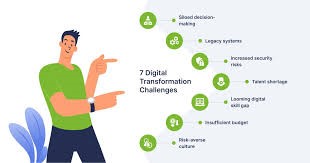Digital Transformation: How Firms Are Going to Adapt Strategies in 2024
Firms in 2024 face a fast-changing technology and consumer-behavior environment. They adapt to these changes by implementing digital transformation strategies to heighten efficiency and customer experience. Innovative ways of harnessing new technologies are explored by businesses in new ways, dramatically shifting their models.
Digital is no longer an option; it is the need for survival. Companies that rise to these challenges are finding new sources of growth and deeper relationships with their audiences. They use technology and data analytics to make better decisions and react at faster times to market demand.
This move to digital is not about the technology; it’s all about new, enhanced business strategies. In such landscapes, winners most probably will define the paradigm of the future of their industries.
Key Takeaways
Businesses are adopting digital strategies quickly to make their processes more efficient.
Investment in technology allows businesses to make better decisions.
Adaptability to digital change is the key to success in the future.
Digital Transformation Strategies
Some of the strategies which companies are focusing on and zeroing in to enhance their digital transformation efforts in 2024 are using big data, adopting cloud solutions, and integrating advanced technologies. These strategies will be very instrumental in enhancing efficiency and withstanding competition.
Leveraging Big Data and Analytics
Big data is the enormous amount of information generated day in and day out. The information may be analyzed by companies to gain insights related to customer behavior and trends in the market. Analytics tools aid the transformation of raw data into information that can be put into use by businesses.
By analyzing the purchase history of customers, companies can create on-target messages. Reports usually say that this type of targeted approach would increase the conversion rate. Companies would be able to adjust the strategies in real-time because of the continuous monitoring of insights of this view; hence, they would become agile in a fast-paced market.
Adoption of Cloud Computing Solutions
Cloud computing is simply storing and accessing data over the internet. This flexibility allows workers to work from anywhere, hence increasing productivity. Options available to firms vary in terms of software, infrastructure, and storage.
The cost can be considerably reduced by switching to cloud solutions. Businesses will no longer need to maintain expensive hardware but only pay for what is used. Enhanced security features are usually provided in cloud services so that data can be considered safe in the modern digital world.

Integration with State-of-the-Art Technologies
Emerging technologies in the form of AI and IoT are reshaping industries. Here, with the help of AI, several routine tasks would get performed by machines, freeing the employee time for more strategic work. The IoT devices gather data from physical objects, thereby making decisions smarter.
Operational efficiency is enhanced, and customer experiences are improved with the integration of these technologies. For instance, a retail company may use the IoT to track the level of inventory in real-time. This would prevent stock out situations and ensure supply chain efficiency. Companies embracing advanced technologies like these will be able to differentiate in the competitive market.
Business Model Implications
Digital transformation in 2024 is going to change how companies conduct business. A few enterprises are shifting to service-oriented models, but remain focused on customer experience enrichment.
Shifting to Service-Oriented Models
Businesses no longer focus on selling products but expand to service provision. Through this shift in strategy, companies can build recurrent streams of revenue. Subscription services have become very popular because they remain relevant and keep providing value to customers.
For example, consider the present day: instead of only selling plain software, the companies are providing cloud-based solutions that enable customers to have easier access to updates and support.
Businesses can leverage analytics to provide services that better meet customer requirements. The more the company adapts to the needs of its customers, the more customer loyalty and satisfaction it will gain.
Advantages of Service-Oriented Models:
- Higher customer retention rate
- Predictable revenue stream
- Deeper insights into customers
- Enhancing Customer Experience
- Most of the businesses nowadays are concentrated on enhancing customer experience. Companies are using technology to drive personalized experiences. It can be in the form of targeted marketing or customized service offerings.
Regarding this, AI and data analytics occupy center stage. They help a business know and understand customer preferences and behaviors.
For example, based on past purchases, retailers use data to recommend products. This not only increases sales but also strengthens the bond with the customer.
Strategies to Enhance Customer Experience:
- Adding chatbots for real-time support
- Direct engagement on social media
- Gathering feedback to drive improvements
- These strategies help enterprises in the process of serving better to the customers and themselves adapting to the digital transformation.
Also Read :
